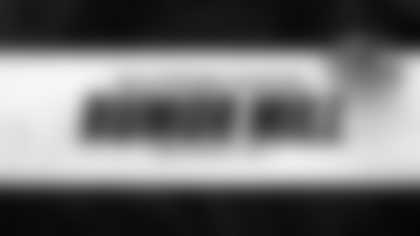The draft is tantalizingly close and the mock drafts are set.
So we figured that BaltimoreRavens.com would take a shot at a full seven-round Ravens draft – all 12 picks.
Obviously, projecting pick No. 247 is no easy task when we don't know who No. 32 will be. This doesn't include any trades because those are totally unforeseen.
But here's our guess, based on the Ravens' areas of need and where prospects are projected to be taken.
NOTE: Like everyone else out there, we have no idea who the Ravens will draft. This is not based on any inside information (that stuff is under lock and key). But enjoy nonetheless.
Ryan Mink
First Round (32): ILB Manti Te'o, Notre Dame
Mel Kiper said there's "no way" Te'o falls to the Ravens at the back of the first round, but I'm not so sure. Prospects always slide and with Te'o's combine performance and the whole fake girlfriend business lingering, it wouldn't be surprising to see teams take a pass when on the clock. Te'o is one of the hardest prospects to predict. If he's there, it makes too much sense for the Ravens to pass. Te'o could likely immediately step into a starting position and Head Coach John Harbaugh is on record saying he would be comfortable drafting him.
Second Round (62): FS D.J. Swearinger, South CarolinaA physical hitter in the back end, Swearinger could step in for the departed Bernard Pollard. Swearinger doesn't have ideal size, standing in at 5-foot-11, but he plays a lot bigger than his frame suggests. The Ravens have said they are in need of safety help, and they've lost some of their muscle on the back end. Swearinger, who also has good ball skills, could be an immediate solution.
Third Round (94): OL David Quessenberry, San Jose State
The first-team All-WAC selection had a strong week at the Senior Bowl, which has caused his stock to rise. He has a big frame at 6-foot-5, 302 pounds and has lots of versatility, something the Ravens covet in their linemen. He played tackle for much of his college career before bumping inside to guard as a senior, and there is some thought that he could play center.
Fourth Round (129): WR Ryan Swope, Texas A&MSwope is a reliable, strong-handed receiver in the mold of departed Raven Anquan Boldin – only with some serious speed. Swope surprised at the combine by running the 40-yard dash in 4.34 seconds. Swope caught 72 passes for 913 yards and eight touchdowns as a senior and showed off his skills in this trick video.
Fourth Round (130): CB Tharold Simon, LSUSimon has the size the Ravens like in their cornerbacks, standing at 6-foot-2, 202 pounds. He's been overshadowed by some of his peer cornerbacks at LSU, but Simon led the team in interceptions (four) with 45 tackles and 13 passes defended once he became a starter. He's confident and a strong tackler.
Fifth Round (165): DT Nicholas Williams, Samford
Williams is a monster, measuring in at 6-foot-4, 309 pounds. He's raw, with just one year of high school football under his belt as he focused on basketball, but has big-time upside and athleticism. He was quicker than top defensive tackle Sharrif Floyd at the combine.
Fifth Round (168): OT Oday Aboushi, VirginiaAboushi has an interesting background as the ninth of 10 children born to Palestinian parents in Brooklyn, NY. He went to Virginia, which has a history of churning out top tackles. Aboushi isn't an elite athlete, but he has a definite nasty streak as a blocker, and iseffective on the edge.
Sixth Round (199): WR Aaron Mellette, Elon
An extremely productive receiver in college, Mellette caught 97 passes for 1,398 yards and 18 touchdowns last season. He's a small-school prospect, but the Ravens haven't hesitated to dip into that pool in the past. Mellette has good size at 6-foot-2, and is good in traffic. He's more quick than fast.
Sixth Round (200): ILB Keith Pough, HowardLike Mellette, Pough is another small-school prospect who the Ravens reportedly showed some interest in this spring. The MEAC Conference Defensive Player of the Year had 72 tackles, 10 for losses with 3 1/2 sacks and four pass deflections as a senior. The Ravens are in dire need of inside linebackers, and Pough would be able to help on special teams as well.
Sixth Round (203): DE Joe Kruger, Utah
The Ravens could stick with the Kruger bloodlines after having success with Paul Kruger, who signed with the Cleveland Browns this offseason. Joe visited Baltimore some when Paul was in town, so the Ravens are familiar with him. He's more of a physical specimen than his older brother, standing at 6-foot-6, 269 pounds. He was a four-year starter at defensive tackle.
Seventh Round (238): TE Matt Furstenburg, MarylandFurstenburg burst onto the scene at the combine with the second-best 40-yard dash time of any tight end (4.62 seconds). It was a surprise considering Furstenburg is known more for his blocking. He is a reliable receiver, however, and may have shown enough promise to develop as a pass catcher.
Seventh Round (247): FB Zach Boren, Ohio State
Another pick that would be familiar for the Ravens. The Ravens signed Boren's brother, Justin, as an undrafted free agent two years ago. The elder was an offensive lineman. Younger Zach was a two-way player for the Buckeyes at fullback and linebacker. He would be a solid special teamer and could contribute with his blocking and receiving on offense.
Garrett Downing
First Round (32): S Matt Elam, FloridaThe Ravens have a need at safety with Ed Reed and Bernard Pollard both gone, and Elam could be an immediate starter. Elam was a standout during his career at Florida, and showed the ability to defend both the run and the pass. He's an aggressive defender that could play strong safety and get paired with free-agent acquisition Michael Huff, who is better suited to play free safety.
Second Round (62): ILB Arthur Brown, Kansas StateHe's a versatile linebacker with the ability to play both inside and outside. Brown (6-foot-0, 241 pounds) doesn't have great size, which has dropped him down some draft boardsand could make him available late in the second round. He brings pass-rush ability and coverage skills, and he could get paired with Jameel McClain as a starting inside linebacker.
Third Round (94): WR Markus Wheaton, Oregon State
Wheaton is coming off* *a strong pre-draft process, where he performed well at the Senior Bowl and the NFL Scouting Combine. Wheaton is a speedy receiver that officially ran a 4.45 in the 40-yard dash, which caught the eye of some NFL scouts at the combine. He also put up big numbers in college, racking up more than 2,100 receiving yards and 12 touchdowns over the last two seasons.
Fourth Round (129): OL Barrett Jones, Alabama
The Crimson Tide lineman is one of the most versatile offensive line prospects in this year's draft. He's played guard, center and left tackle, making him a good fit for a Ravens line with a number of moving pieces. Jones likely projects as a center in the NFL, and could challenge Gino Gradkowski for a starting job.
Fourth Round (130): QB Landry Jones, Oklahoma
The Oklahoma quarterback was once considered a sure-fire first-round pick, but his production trailed off during his last two college seasons and dropped him down draft boards. He has a strong arm and was a four-year starter in college, which could make him a potential target to add competition behind Joe Flacco. Ozzie Newsome said the Ravens would be open to drafting a quarterback, and Jones could be a nice fit.
Fifth Round (165): WR Cobi Hamilton, ArkansasHe is a big wide receiver that had a highly productive college career. Hamilton caught 90 passes for 1,335 yards and five touchdowns last year. Hamilton has decent speed and can play over the middle, which could give the Ravens another player to compete to replace Anquan Boldin.
Fifth Round (168): DT Akeem Spence, IllinoisEven with the additions of Chris Canty and Marcus Spears, the Ravens could still use some additional support in the middle of the defensive line. Spence has good speed and explosion, but lacks the size and ability of a run-stuffing defensive tackle. He could learn behind the veterans and also put on some bulk this offseason.
Sixth Round (199): CB Brandon McGee, Miami
McGee was a solid cornerback at Miami, and last year he registered two interceptions and a sack. He has good speed, which he showed off by running the 40-yard dash in 4.40 seconds. McGee has plenty of talent, and could develop into a strong pro with some time to develop.
Sixth Round (200): S Earl Wolff, N.C. State
Wolff had a strong week at the East-West Shrine game, which could have helped his draft stock during the pre-draft process. He's comfortable coming up to defend the run and is a sure tackler, which could make him a solid addition to the special teams unit.
Sixth Round (203): OT Reid Fragel, Ohio State
Fragel started his career at Ohio State as a tight end, but he was moved to right tackle during his senior season. He showed good potential as a tackle, but is still raw and somewhat of a project. He has good athleticism and could bloom under new coach Juan Castillo, who has a history of developing raw offensive line prospects.
Seventh Round (238): ILB Michael Mauti, Penn State
Mauti was an emerging prospect this year before going down with a torn ACL late in the season. The injury will likely push him to the end of the draft, but he could be a steal if he's able to make a full recovery.
Seventh Round (247): OLB/DE Nathan Williams, Ohio State
Williams was a highly-regarded player early in his college career, but dealt with a knee injury in 2011 that slowed him down his last two seasons. He can defend the run and get after the passer, and would be a hybrid player in the Ravens'3-4 scheme.


















